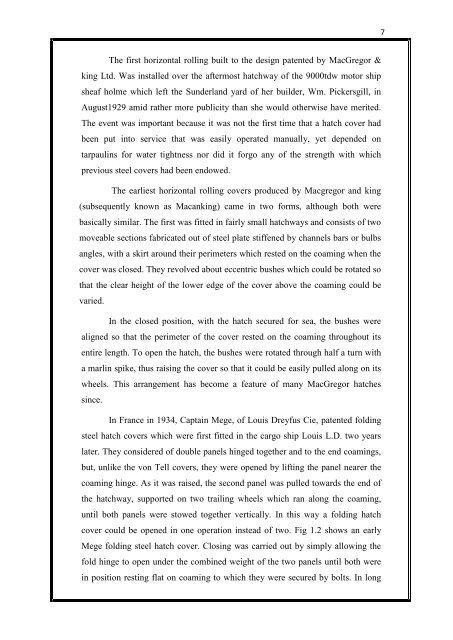Single pull macgregor type hatch cover.pdf - Cochin University of ...
Single pull macgregor type hatch cover.pdf - Cochin University of ...
Single pull macgregor type hatch cover.pdf - Cochin University of ...
Create successful ePaper yourself
Turn your PDF publications into a flip-book with our unique Google optimized e-Paper software.
The first horizontal rolling built to the design patented by MacGregor &<br />
king Ltd. Was installed over the aftermost <strong>hatch</strong>way <strong>of</strong> the 9000tdw motor ship<br />
sheaf holme which left the Sunderland yard <strong>of</strong> her builder, Wm. Pickersgill, in<br />
August1929 amid rather more publicity than she would otherwise have merited.<br />
The event was important because it was not the first time that a <strong>hatch</strong> <strong>cover</strong> had<br />
been put into service that was easily operated manually, yet depended on<br />
tarpaulins for water tightness nor did it forgo any <strong>of</strong> the strength with which<br />
previous steel <strong>cover</strong>s had been endowed.<br />
The earliest horizontal rolling <strong>cover</strong>s produced by Macgregor and king<br />
(subsequently known as Macanking) came in two forms, although both were<br />
basically similar. The first was fitted in fairly small <strong>hatch</strong>ways and consists <strong>of</strong> two<br />
moveable sections fabricated out <strong>of</strong> steel plate stiffened by channels bars or bulbs<br />
angles, with a skirt around their perimeters which rested on the coaming when the<br />
<strong>cover</strong> was closed. They revolved about eccentric bushes which could be rotated so<br />
that the clear height <strong>of</strong> the lower edge <strong>of</strong> the <strong>cover</strong> above the coaming could be<br />
varied.<br />
In the closed position, with the <strong>hatch</strong> secured for sea, the bushes were<br />
aligned so that the perimeter <strong>of</strong> the <strong>cover</strong> rested on the coaming throughout its<br />
entire length. To open the <strong>hatch</strong>, the bushes were rotated through half a turn with<br />
a marlin spike, thus raising the <strong>cover</strong> so that it could be easily <strong>pull</strong>ed along on its<br />
wheels. This arrangement has become a feature <strong>of</strong> many MacGregor <strong>hatch</strong>es<br />
since.<br />
In France in 1934, Captain Mege, <strong>of</strong> Louis Dreyfus Cie, patented folding<br />
steel <strong>hatch</strong> <strong>cover</strong>s which were first fitted in the cargo ship Louis L.D. two years<br />
later. They considered <strong>of</strong> double panels hinged together and to the end coamings,<br />
but, unlike the von Tell <strong>cover</strong>s, they were opened by lifting the panel nearer the<br />
coaming hinge. As it was raised, the second panel was <strong>pull</strong>ed towards the end <strong>of</strong><br />
the <strong>hatch</strong>way, supported on two trailing wheels which ran along the coaming,<br />
until both panels were stowed together vertically. In this way a folding <strong>hatch</strong><br />
<strong>cover</strong> could be opened in one operation instead <strong>of</strong> two. Fig 1.2 shows an early<br />
Mege folding steel <strong>hatch</strong> <strong>cover</strong>. Closing was carried out by simply allowing the<br />
fold hinge to open under the combined weight <strong>of</strong> the two panels until both were<br />
in position resting flat on coaming to which they were secured by bolts. In long<br />
7

















